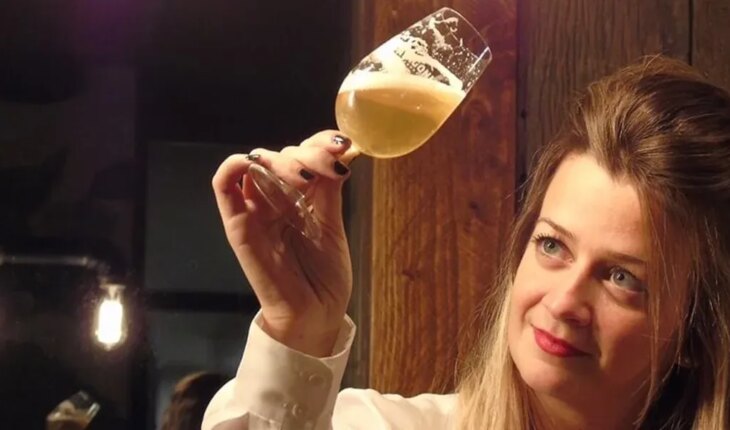It is today that Sol Cravello is grateful for not having followed the advice she was given when she was taking one of the last subjects to graduate with a Bachelor’s Degree in Food Technology. “I’m going to approve you, but don’t ever get into beer.”a teacher told him. Not only does he remember that text, but he prides himself on ignoring it. Currently, she is one of the most recognized beer sommeliers in our country and these days she plays in the highest category by being a judge in the Beer World Cup, which will be defined on April 24 under the lights of Las Vegas. Despite any obstacles, he was destined to be a brewer: “I didn’t like beer and I don’t like fizzy drinks. But when I started to understand it and we started doing sensory analysis in the first job I had (coordinator of the sensory panel), it was fascinating, I started to love it,” she says.Sol Cravelo is one of Argentina’s most renowned beer sommeliers and will be a judge at the Beer World Cup. Photo: Cervecería y Maltería Quilmes.The porteña has more than a decade of experience in the beer industry and focuses on teaching and training consumers, restaurants and bars about this drink, which is one of the most loved by Argentines. In addition, it is the first South American to receive a Cicerone certification in beer understanding.” I want to eradicate the idea that only wine can be in a gourmet dinner,” he says in a chat with Filo.news from the United States, where she waits “excitedly” to participate in the World Cup, the highest step a beer judge can reach. The role of women in the brewing worldWith the satisfaction of knowing that she earned a place as a benchmark within an industry historically linked to men, Cravello acknowledges that many women still struggle to be respected in the environment.“It’s difficult to position yourself as a woman in the world of beer,” says Sol Cravello, despite her personal pride in having earned a place of respect within the industry. Photo: Instagram @solcravello.“From Quilmes I always had a very privileged place because the company trained me a lot, it allowed me to travel to take exams… I was always like a role model, I felt respected and that gave me a lot of satisfaction and pride,” she says. Although she clarifies: “It’s difficult to position yourself as a woman in the beer world. There are a lot of colleagues who if they don’t have 300 courses and a lot of certifications, they don’t have the voice to talk about beer like a man can. In a brewery, maybe they don’t hire them because they think they can’t lift a bag of malt or they don’t have the physical capacity to work on-site.” Even so, the sommelier of Cervecería y Maltería Quilmes points out that there are groups of women brewers who have been going strong. “I used to go to the competitions alone and now there are more and more female judges. There are also more women speakers at conferences or congresses. Little by little they are getting involved because there is a lot of talent and very rude girls who are making themselves respected. But there is a prejudice first and you have to earn that place more than men,” she says. “I want to eradicate this idea that only wine can be in a gourmet dinner”Beer myths and the ABCs of wine pairingIs beer drunk cold? “For competitions or quality analysis, a very cold beer completely cancels out your taste buds, the aroma and everything,” says Cravello. And he explains: “In the day-to-day life of people who drink beer, there is a big division between soft beers, which are golden, light, have low bitterness, without much aromatic character and are very light. They do come into the world to quench thirst, to refresh. You take those at one or two degrees and that’s fine because they have that role.” Then there is a huge and beautiful world at an aromatic level where, for example, a beer with 10% alcohol, a lot of malt, which was previously aged in a barrel that had Bourbon or Malbec or whatever… Everything that the wood, the aging, the Bourbon brings, if you take it to a degree, you miss out on a beautiful world and it doesn’t make a lot of sense. So depending on the occasion and style, it is taken colder. In Europe it’s 11 or 12 degrees and they’re used to it, but here it’s like, ‘What!?'”Sol Cravello teaches and trains consumers, restaurants and bars about beer, one of the most loved by Argentines. Photo: Cervecería y Maltería Quilmes.When it comes to choosing what to pair the beer with, Cravello teaches that hThere are three basic principles to achieve the ideal pairing.-A, to align: “I can’t eat a very spicy, heavy lamb stew, with some creamed potatoes and a light beer, because there the stew is eaten with beer. Nor the other way around, that is, a dark, aged, bitter beer, with a lot of character and body, with some chips, because there the beer is eaten on the plate. Then you have to align the intensities. If I have a lot of fat, I’m going to try to accompany it with a lot of alcohol, bitterness, a lot of body. We have to balance so that no one is the protagonist and they are equal.” B, for bridge: “The idea is to create a bridge of flavor and try to find a flavor that the beer has and an ingredient that the dish has. For example, a Tiramisu that has coffee with a dark beer that may have a note of coffee or roasted malt. So, coffee with coffee generate a bridge of flavor. Or it can be an Amber beer that has caramel malt with something that’s grilled or has onion caramelization or is sweet and sour.” C, for cut or contrast: “Thanks to its gas and sometimes bitterness, beer can generate a cut in the dish and reset your palate a little. For example, a bitter beer can cut and contrast with something sweet, so it doesn’t make you cloying and beer doesn’t generate as much bitterness.”
Original source in Spanish
The Argentinian who stands out in the world of beer, reveals beer myths and secrets for choosing the ideal pairing
April 24, 2024 |





